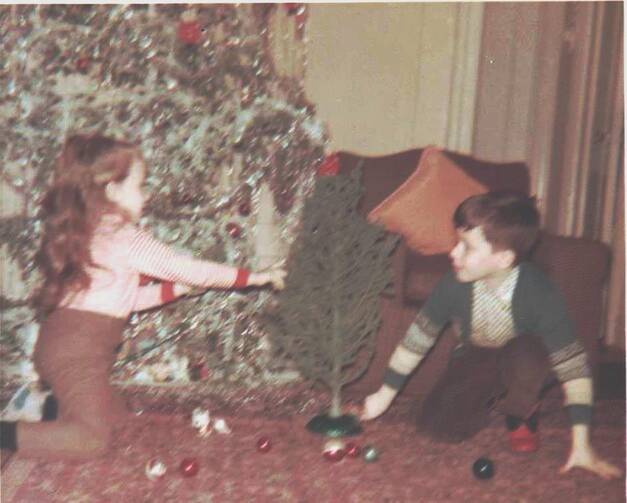There is something about Christmas trees that captures the imagination of a child. A beautifully decorated and brightly lit tree can do wonders for a child’s spirit, not to mention an adult’s—especially after spending hours upon hours getting it just right, with arranging and re-re-rearranging the assorted ornaments and lighting to achieve just the right effect to everyone’s eventual delight. But to a child, a Christmas tree is much more than the accumulation of decorations and lights, tinsel and garland. For a child, a Christmas tree is a promise.
For someone who has gotten the chance to live through a little more than a half-century of seeing Christmas trees come to light—and life—before my very eyes, it does not seem possible that a decorated Christmas tree has still the same effect as it did when I was a youngster, but it always does. When that time of year comes around again, I still get that warm feeling that artists have always tried to capture on canvas and process through the ubiquitous greeting card; it is unexplainable and inexpressible, yet deeply felt nonetheless.
For a child, that feeling might be that of security, knowing that you are at home, surrounded by people who love you; or it can be that sense of expectation that something wonderful is about to happen but you can’t quite say what it is or understand it. But you know that whatever it is, it is something very special. You sense that you are about to enter a unique time of the year when the adults become even busier than usual, with the scurrying about to do extraordinary things like cleaning up the house, putting up decorations, writing cards and letters to friends and relatives, buying presents and all kinds of gifts, preparing or buying special foods or watching TV specials and movies (even the commercials!), listening to holiday music or hosting a holiday get-together. And putting up that Christmas tree, whether it be the one from the woods or the artificial one from mall. Yes, with the years you may get older, but the days of Christmas never do.
But for an adult, what is a Christmas tree, or, for that matter, Christmas itself? We know, of course, that it is the day that Jesus, the Son of God, became the God-Man, the Emmanuel who entered humanity so that he could offer us his eternity. God became human so that he could be alongside us on our earthly journey while at the same time reveal to us his divinity and show us the possibilities of heaven with the Father. Of course, we don’t fully realize this when we are children; but, somehow, we have but a glimmer of it just the same. As children, we learn—and know—that God did something spectacular for us by becoming one of us.
As children, we can easily relate to other children like us, which God became in Jesus’ human form, first as a baby. Children understand birthdays, since everyone has them and looks forward to the celebration that accompanies them. (Whereas, an adult—well, let’s just say that for some, it’s an acquired taste.) And children readily understand a “helpless babe in swaddling clothes,” though they might not quite grasp what “swaddling” means. But children do understand the “helpless” part because they, too, need that help that grownups provide, for they cannot survive without them or that help.
Adults realize this of course, and given what an adult is—and must be—often they fall prey to forgetting something very important. Sometimes—oftentimes!—adults let the business of being one get in the way of treasuring Christmas and its meaning, something a child never does. Because of the “busyness” and the business of life, adults unfortunately tend to bury this aspect of their childhoods and may find themselves at a loss as to how to recapture that long dormant feeling of their past. If they’re lucky enough to remember what it was like and how it felt, they will have no difficulty in retrieving that part of themselves that had seemed beyond reach and forever lost; they might even, if fortunate, get to revel in it, even for a time.
But to come back to that child and the Christmas tree: it is something almost magical when the child becomes present before this brightly-lit testament to faith, hope and love. It is as if an encounter—to appropriate Pope Francis’ word—is taking place. At this moment, the imagination of the child is receptive to these branches that represent so much. Perhaps it is better to say that the heart of the child is open to more than just the mere physical gifts that are spread beneath the tree; the child’s heart is more receptive to the possibilities that Christmas offers that the jaded and often hardened adult heart would be.
In a Christmas tree, a truly prescient child sees more than the physical aspect of it; the child sees beyond the surface appearance of glitter and garland, lights and tinsel; the child sees faith, hope and love, things which they are ready to give at every moment of their lives, whether it is Christmastime or not. These are the real gifts that they want and are always ready to give to others.
It is the child that easily spreads out arms and hands in gestures of acceptance and welcome to whomever they meet. It is the child who wants gifts that last longer than the time it takes to rip the wrapping paper and putting it aside the toy that held just a momentary interest. It is the child who wants everyone to be happy like they are and wishes everyone to be that way, even when things don’t turn out the way it ought to or the way we’d like.
It is the child that wants everybody to have a share in the bounties of life, whether it be that extra slice of cake or the extra dollop of ice cream that should come with it or to have warm things like clothes or comforters to ward off the night time chill or to have a loving presence beside them in the shadows of the night to ward off the fears and the uncertainties that make up the daytime of life. And it is the child who wants life to be good and who wants everyone to have a share in such a life. For all that and more, a child senses and sees something special in that Christmas tree.
On Christmas Eve and Christmas Day, children everywhere will appear before that Christmas tree, ready to lay claim on its promise. And when they do, they will look down at a manger scene, with a representation of another child—“a babe in swaddling clothes”—and recognize themselves in that Child lying on the straw. And then, they will look up, and gaze at those brilliantly colored lights beneath that great star of gold atop the Christmas tree, which represents another and more lasting Light.
“Be a child at Christmastime,” so says the song. Yes, let us be children again at Christmastime. We need to be children again, if we want to possess the promise of Christmas that we seemed to have lost. Let us see like children again and come unto the Child who came among us. May we grasp this promise and if we do, our jaded adult selves will thank us for this gift and our Christmases will truly be “merry and bright.”








